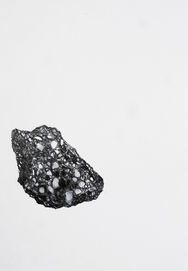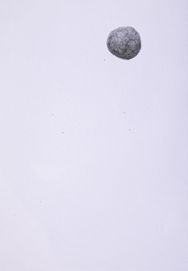
HOLD THE LINE is an ongoing project unearthing historic refugee routes taken by people across the world with the aid of a Nansen Passport. These journeys, first made almost a century ago are uncovered and re-traced on foot.
Each journey undertaken is represented through a series of drawings of the small stones passed along the way. Each stone is rendered twice, with the first sent to people around the world who would like to connect with the journey, the second forming part of a lasting archive.
In 2019 the Nansen Passport refugee journey of Pavel Kiprianovitch was retraced on foot, 90 years after his original departure in 1929, from Bulgaria to France.
Michael Horswell, at University of the West of England Human Geography Department, created a live map of the route which tracked my journey while I was taking it. For the duration of my travels, people would be able to click to see where I was on route, and view photographs of my journey re-tracing Pavel's.
A text written in response to this journey can be viewed at https://dark-mountain.net/eleven-stones/
The stone archive for Pavel's journey can be viewed below
HOLD THE LINE
Eleven Stones
I have spent three years tracing other people’s journeys; this journey is Pavel’s.
In 1922 Fridtjof Nansen, a Norwegian arctic explorer and marine biologist, created the historic ‘Nansen Passport’ in his role within the League of Nations, to aid the thousands of stateless people caught in the wake of the 1917 Russian Revolution and the First World War. Under Nansen, this commission became the first to define international refugee status, and his passport offered sanctuary to thousands of displaced people unable to return to their country of origin by providing the means to cross borders in the pursuit of new lives. By 1942, the passport was recognised by 52 countries; 53 by today’s borders. In 1929, Pavel Kiprianowitch Kastorny used a Nansen Passport to make one of the 450,000 journeys taken with the aid of this document, from Bulgaria to France.
Pavel’s passport is frustratingly lacking in details. It records he was born in Kuben, southern Russia in 1894, and his Nansen journey was from Sofia to Saint-Louis, but nothing more. From his birthplace, I assumed he had fled Bolshevik Russia, though everything else remained a mystery. Some of these details have been uncovered through a fortuitous connection with a Norwegian woman who knew Pavel in Ålvik in the 1950s. When happening upon my project she got in touch, shining a light on an otherwise hidden life: a soldier in the White Army, Pavel fled Russia in 1921 to settle as a land worker in Bulgaria. He was issued his Nansen Passport in 1929, which took him to France. His story continues from there; during the Second World War he was forcibly moved to Germany by the Nazis to work for the weapons industry. After the war he was again displaced, but was offered sanctuary in Norway through the Norwegian humanitarian organisation Nansenhjelpen (set up by Nansen’s son). He later settled in Hamar, near Oslo, marrying an Estonian refugee, Sinaida. Pavel died on 16 June 1982.
Pavel’s was one of the first such journeys I found; his passport tucked away in the museum at the Fridtjof Nansen Institute in Oslo. The institute is in Nansen’s house; his grave is in the garden. It seemed somehow auspicious that Pavel’s passport, out of thousands, should be the one to end up back at the start. Something else hit me when tracing his passage by the stamps on the document: the striking resemblance to the Balkan Route which contemporary migrants are travelling today. Both routes span Europe almost from East to West.
In a period of Brexit and increasingly politicised migration, the route appeared as an inadvertent echo of today’s refugee crisis. I would re-trace Pavel’s steps 90 years after he took them in an act of remembrance and unity; a pilgrimage and protest march.
I first travelled Pavel’s journey with my fingers, feeling the contours of this route along paper maps, sliding across flat glossy surfaces that depicted mountain terrains and ravines, before ebbing into the creases of the paper folds. There was discordance between the clean simplicity of these maps that didn’t correspond to the complex images they beheld. I mapped it online, which showed, taking the most direct course, a distance of 1,710 kilomeres; ambitiously predicted by Google that on foot, I would reach my destination after 310 hours of continuous walking. I would follow this plotted line across borders, along coastlines, over expanses of industrial wastelands and miles of flat dirt roads. When you trace a journey this way, it feels as if you travel across your environment, whereas in reality you are always travelling through it. There is an ingrained pragmatism to maps, they give you a God-like perspective, arming you with far-reaching range; yes there are mountains now, but soon you will reach the coast and the switchback roads will give way to much gentler, sandy paths.
Though I’ve never found a journey to be rational in this way, a mountain is still a mountain when you have to cross it, and a steep incline can feel like a mountain, and a stone in your shoe can also feel like a mountain.
A mountain is still a mountain when you have to cross it, and a steep incline can feel like a mountain, and a stone in your shoe can also feel like a mountain
Pavel Kiprianowitch Kastorny made this passage in 1929, travelling from Bulgaria to France. The dates on the passport show he took 11 days to make this journey, I imagine on foot, taking trains and other means of transport between countries, as the border stamps show he passed through Dragoman and Jesenice; both major rail links.
Ninety years on, in 2019, I retraced his footsteps, crossing nine countries in 11 days to get from Sofia to Saint-Louis. I shared this crossing intimately with a stranger. Though I’ve searched, I’ve never even seen a picture of Pavel; his passport depiction describes blond hair and brown eyes, with neither moustache nor beard. He was 34 at the age he took the journey, I was also this age when I made it.
I decided to draw the small stones I found along my path as I travelled. I liked the idea that these insignificant, unnoticed parts of the landscape were free to move across this landmass, absently kicked over and along borders. Stones are actual pieces of geography, physical parts of the environment, the intimately local mixed in with imported gravel from across the world. This landscape was my connection to Pavel, as I walked across the landmass of Europe, today divided by far more borders than in Pavel’s time after the dismantling of Yugoslavia and subsequent wars: I hoped our feet may have trodden some of the same ground,
I drew two portraits of each stone I found. I saw these as depictions of both journeys; the original journey of Pavel’s, and mine 90 years later. One of each of the stone drawings was individually posted out to people and places across the world, while the other stayed with me as I went in a cumulative archive. I drew 120 stones in all; this one journey creating many more ephemeral ones as each stone travelled a separate direction to arrive in a different letter box. I threw stones out from my path, some dropped too soon, falling short of their destination though nevertheless arriving somewhere else.
These stones formed my connection to others. It is through these stones that I invite you to travel this journey now. I hope these fragments can tell a quiet story of landscape and place, connection and transformation across distance.









Stone/day 1: Dragoman
The first day of the journey feels hard. I wake early, and walk through quiet streets in Sofia wondering what Pavel must have felt at the very beginning of this crossing, relief, anticipation, trepidation? I feel a mixture of all three. The weather’s oppressive; a dirty, smudged cloth hanging close and wet around me, the distance ahead also weighs heavy. The first destination is Dragoman, near the border with Serbia and the first stamp on Pavel’s passport. It’s pretty, small and rural and flanked by distant mountains. Sunflowers grow around small houses with burgeoning gardens. I see few people in the village, some old men weeding and one walking his donkey through the streets. I draw the stones found on the road, slow seems to be suited to my surroundings.
Stone/day 2: Niš
On the long route into Niš, Serbia, I walk into town along a dilapidated street, a tree has grown up inside a derelict shop, its trunk appearing through the glassless front window and again as it rises up through the collapsed roof, a man rides past on a bike with two children perched in front and behind him.
Stone/day 3: Cacak
I arrive here late afternoon, it’s hot and dusty, the stones I find on the side of the road all seem to be formed from broken fragments of tarmac.
Heading 1
Stone/day 4: Serbian border
Waiting at the border to cross, the landscape is sparse and open. I pick up this hard, terse little stone and hold it in my hand as I wait.
Stone/day 5: Bosnia
Approaching Sarajevo, climbing over the crest of a hill to see the city jostling below I notice two signs; welcoming me to Sarajevo and telling me I was leaving the Srpska Republic. The tarmac on the road has been resurfaced recently on the Sarajevo side; it stops at the border demarcating it in a thick black line. I think of the myriad new border lines etched across this landmass since Pavel first took this road.
Stone/day 6: Croatia
Along Croatia’s sun-bleached coast I find this white, almost translucent stone, it seems somehow shell-like, iridescent.
Stone/day 7: Jesenice
A long day’s travel past remote farmland and up through mountains to reach the border town of Jesenice. I pass a quiet night here, walking the strip of shop fronts in the early evening, watching the groups of gathered men sitting on the pavements with portable stereos and beer. Stones have been hard to find in Slovenia, the roads are swept clean; I find only tiny, gritty chippings.
Stone/day 8: Villach
I cross into Austria after a week of travelling; spending a few restful hours under the shade of a tree in the town square, drawing the round pebbles caught nestled in the cobblestones.
Stone/day 9: Munich
Munich feels large in comparison to where I’ve been. The stones I find are bigger too, and appear more frequently.
I think often of Pavel, but he feels remote to me here.
The hours lost at border points crossing through the Balkans have been reduced to minutes; the scrutiny replaced by a cursory glance and nod from the guard when passing between Slovenia, Austria and Germany.
Similarly the border stamps on Pavel’s passport go mysteriously unrecorded at this point.

Stone/day 10: Basel
I rest on the afternoon of the tenth day in Basel, before the walk to France the next day. Two people are dancing on the street to a portable record player.
Pavel will have passed here.
Heading 1

Stone/day 11: Saint-Louis
I walked over the border from Switzerland to France at six minutes past eleven on the eleventh day. The border guard, inside a hut in the middle of the road was sitting at a desk, bent over something; he seemed to be reading and didn’t even look up.
I crouch down and collect this stone, I think of Pavel.
























